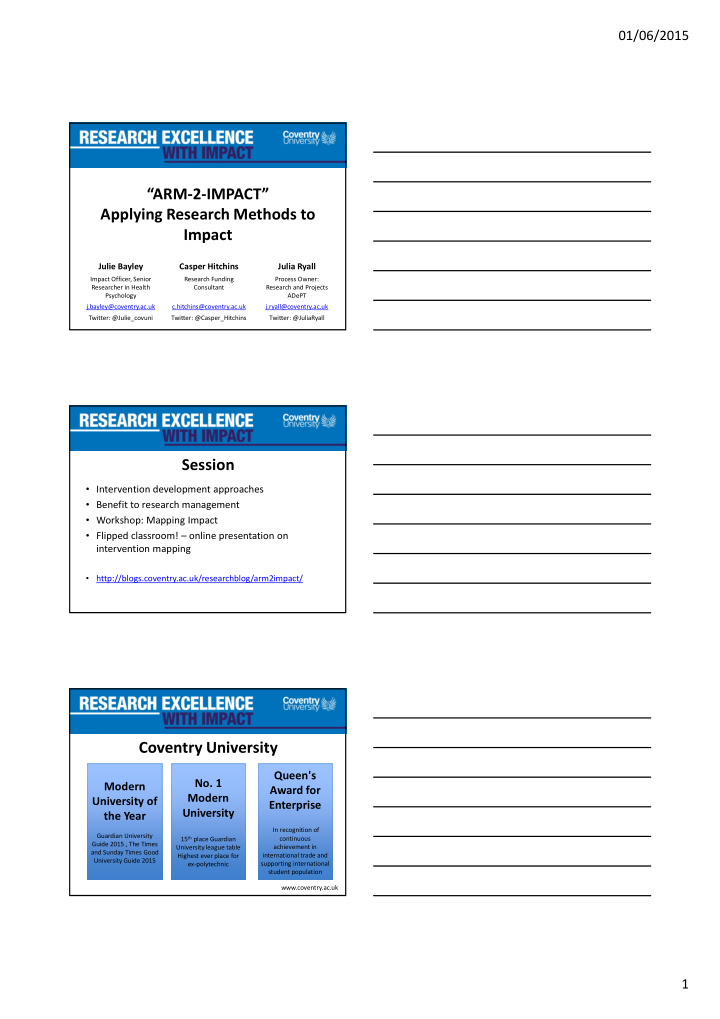



01/06/2015 “ARM-2-IMPACT” Applying Research Methods to Impact Julie Bayley Casper Hitchins Julia Ryall Impact Officer, Senior Research Funding Process Owner: Researcher in Health Consultant Research and Projects Psychology ADePT j.bayley@coventry.ac.uk c.hitchins@coventry.ac.uk j.ryall@coventry.ac.uk Twitter: @Julie_covuni Twitter: @Casper_Hitchins Twitter: @JuliaRyall Session • Intervention development approaches • Benefit to research management • Workshop: Mapping Impact • Flipped classroom! – online presentation on intervention mapping • http://blogs.coventry.ac.uk/researchblog/arm2impact/ Coventry University Queen's No. 1 Modern Award for Modern University of Enterprise University the Year In recognition of Guardian University 15 th place Guardian continuous Guide 2015 , The Times University league table achievement in and Sunday Times Good Highest ever place for international trade and University Guide 2015 ex-polytechnic supporting international student population www.coventry.ac.uk 1
01/06/2015 Interventions and impact Impact planning • Often poorly mapped: – Mismatched outputs / activities / audience / impacts – Limited linearity • ‘Default’ activities • Assume activities lead to impact • Assume exposure leads to impact • Focus on broad not achievable impacts • Overlook the realities of implementation Stakeholders Activities Impact 2
01/06/2015 Intervention Mapping • Intervention = change activity • Intervention Mapping (Bartholomew et al, 2006) – Framework incorporating user views, expert opinion, theory and evidence – Determine actual needs – Determine the changes needed and what is amenable to change – Select methods accordingly – Create a coordinated strategy – Implement and evaluate Stakeholders Their issue BROAD Change needed (impact) PROBLEM Their need Activity Using intervention approaches in research management: the hybrid approach 3
01/06/2015 Impact in research management • Can be difficult to support impact: – Not impact expert – ‘Academic as expert’ – Time available A ‘hybrid’ approach • Impact plans are mapped (matched) – Outputs / activities / audience / impacts – Clear, defined paths • Articulates how activities lead to impact • Focus on achievable impacts within broader impact goals • Accommodate and acknowledge realities of implementation Benefit to research managers • Drawing on intervention methods arms research managers to: – Support realistic impact planning – Create and follow feasible project management plans – Support, question and challenge academic plans – Offer informed, objective review – Be a ‘critical friend’ 4
01/06/2015 Activity: Mapping Impact The reality of impact planning • Often academics need support to strengthen their impact plans • May have only basic ideas • Research managers can apply logical approach, even with limited information Stakeholders Their issue BROAD Change needed (impact) PROBLEM Their need Activity 5
01/06/2015 PROBLEM (social, economic or environmental issue on which the project is based): Who? Their issue Impact (the Their need Activity (How (Stakeholders, (their ‘part’ of the change needed) (what do they will they be beneficiaries, problem) need to make the reached?) users) change?) PROBLEM (social, economic or environmental issue on which the project is based): What is the real world problem? Who? Their issue Impact (the Their need Activity (How (Stakeholders, (their ‘part’ of the change needed) (what do they will they be beneficiaries, problem) need to make the reached?) users) change?) Person/ group Outline what their Knowing what E.g.. Do they What activity/ particular issue is their problem is, need information? output etc will within the broader work out what a Attitude change? best meet the problem solution looks like Evidence to lobby need and the (impact goal) with? New audience? product? PROBLEM (social, economic or environmental issue on which the project is based): Who? Their issue Impact (the Their need Activity (How (Stakeholders, (their ‘part’ of the change needed) (what do they will they be beneficiaries, problem) need to make the reached?) users) change?) 6
01/06/2015 PROBLEM (social, economic or environmental issue on which the project is based): Who? Their issue Impact (the Their need Activity (How (Stakeholders, (their ‘part’ of the change needed) (what do they will they be beneficiaries, problem) need to make the reached?) users) change?) PROBLEM (social, economic or environmental issue on which the project is based): Who? Their issue Impact (the Their need Activity (How (Stakeholders, (their ‘part’ of the change needed) (what do they will they be beneficiaries, problem) need to make the reached?) users) change?) PROBLEM (social, economic or environmental issue on which the project is based): Who? Their issue Impact (the Their need Activity (How (Stakeholders, (their ‘part’ of the change needed) (what do they will they be beneficiaries, problem) need to make the reached?) users) change?) 7
01/06/2015 PROBLEM (social, economic or environmental issue on which the project is based): Who? Their issue Impact (the Their need Activity (How (Stakeholders, (their ‘part’ of the change needed) (what do they will they be beneficiaries, problem) need to make the reached?) users) change?) PROBLEM (social, economic or environmental issue on which the project is based): Who? Their issue Impact (the Their need Activity (How (Stakeholders, (their ‘part’ of the change needed) (what do they will they be beneficiaries, problem) need to make the reached?) users) change?) The impact puzzle….finding the pieces 1. Read the scenario 2. Write down the problems, activities, stakeholders and impacts you see on separate post its. 3. Put each of these on the grid. Those that ‘match’ go on the same row, those that don’t go on different rows. 4. Look at what you have. Do you have a full row? ( if not, you don’t have a pathway! ) 5. Try to fill in the gaps with some sensible ideas 6. Draft feedback to the academic in how they could improve the plan 8
01/06/2015 Summary Be logical Be objective Be ARMED! 9
Recommend
More recommend